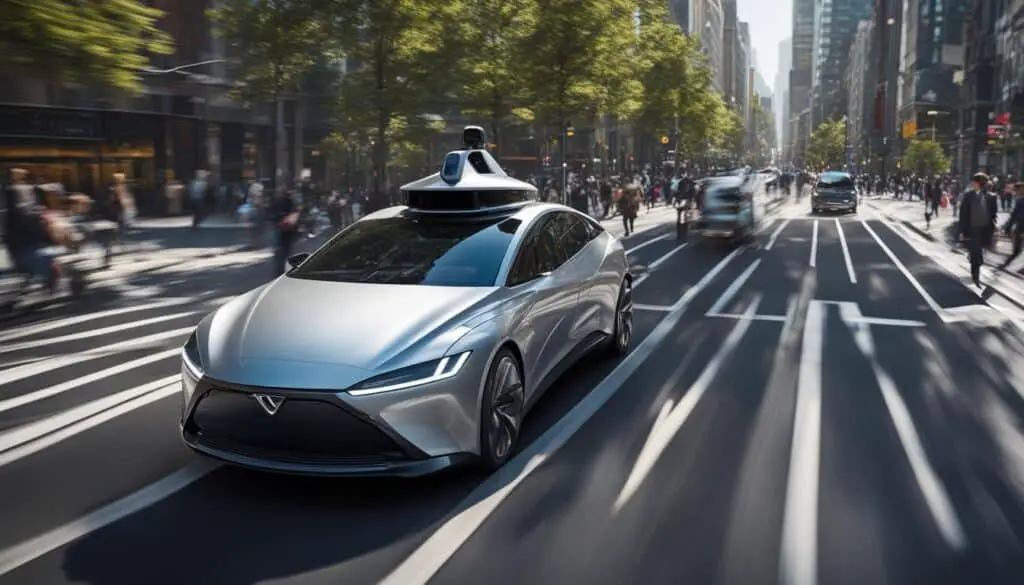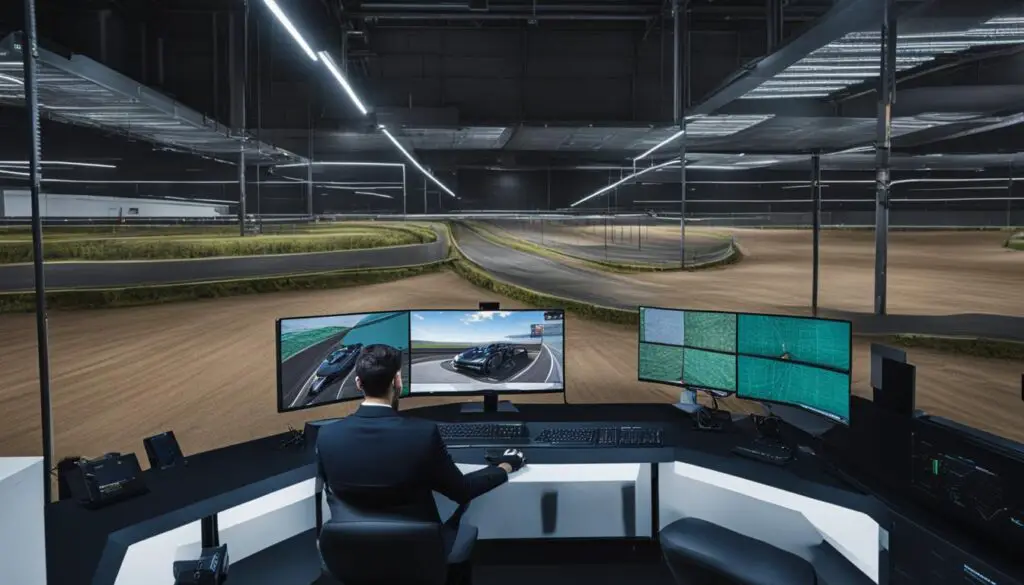
The Crucial Role of Human Oversight in Autonomous Driving
When it comes to autonomous driving, the role of human oversight cannot be underestimated. While AI systems and algorithms have the potential to revolutionize transportation, it is essential to recognize the importance of human involvement in ensuring safety and reliability. As we delve into the world of autonomous vehicles, we must understand the significance of meaningful human control in this rapidly evolving technology.
Key Takeaways:
- The role of human oversight is crucial in guaranteeing safety and reliability in autonomous driving.
- Meaningful human control is necessary to address potential risks and ensure responsible decision-making.
- Human oversight is essential in preventing harm caused by algorithms and discriminatory decisions.
- Challenges with human oversight, such as automation bias, need to be addressed for effective implementation.
- Testing and continuous improvement of human oversight are vital for enhancing the safety and efficiency of autonomous driving technology.
The Need for Meaningful Human Control in AI Systems
Algorithms driven by machine learning and AI are increasingly influencing and shaping various aspects of our lives. While these technologies hold the potential to address significant challenges and improve efficiency, they also come with inherent risks and ethical considerations. As a result, there is a growing recognition of the need for meaningful human control over these powerful algorithms to ensure transparency, accountability, and ethical decision-making.
Meaningful human control refers to the ability for humans to understand, interpret, and influence the decisions made by AI systems. It involves placing human judgment at the forefront of decision-making processes, particularly in situations that require moral reasoning, value choices, and nuanced understanding of social contexts.
The Role of Ethics in AI Systems
When it comes to AI systems, ethics play a crucial role in guiding their development and application. As these technologies become more autonomous and capable of making complex decisions, it becomes imperative to consider the potential consequences of their actions. Ethical frameworks provide a set of guidelines and principles that ensure AI systems are aligned with human values and adhere to moral norms.
“Ethics needs to be at the center of AI system development to ensure that the decisions made by these systems align with our shared values and promote the well-being of individuals and society as a whole.”
By incorporating ethical considerations into AI systems, we can mitigate biases, address fairness concerns, and build trust among users and stakeholders. This is especially important when deploying AI and robotics in critical domains such as healthcare, finance, and autonomous driving, where the impact on individuals and society can be significant.
Examples of Meaningful Human Control
Meaningful human control can take various forms, depending on the specific context and application of AI systems. In the field of autonomous driving, for instance, human control is essential to ensure safety, ethical decision-making, and public trust.
The United States military, in its Department of Defense Directive, emphasizes the importance of “appropriate human judgment” in the use of autonomous weapons systems. This directive acknowledges that human oversight is vital to prevent unintended escalation, minimize civilian casualties, and adhere to ethical and legal standards.
Similarly, the European Commission has proposed a regulatory framework for AI systems that pose high risks to safety, security, or fundamental rights. The proposed legislation emphasizes the need for human oversight, transparency, and accountability in the development and deployment of these systems.
These examples demonstrate that meaningful human control is a global concern, with governments, organizations, and experts recognizing its significance in ensuring responsible and beneficial AI systems.
Benefits and Challenges
The integration of meaningful human control into AI systems offers several benefits. It allows for explainability, enabling individuals to understand how decisions are made and actions are taken by these systems. It also provides avenues for redress and accountability when AI systems err or cause harm.
However, implementing meaningful human control is not without its challenges. Achieving a balance between human oversight and the autonomy of AI systems requires careful consideration. Overreliance on human judgment may hinder the efficiency and scalability of AI systems, while insufficient oversight may lead to unintended consequences or the entrenchment of biases.
Furthermore, ensuring meaningful human control necessitates interdisciplinary collaboration, as it requires expertise in AI, ethics, psychology, law, and social sciences. Developing effective frameworks and guidelines for human oversight is an ongoing endeavor that demands continuous research, dialogue, and international cooperation.
Different Purposes of Human Control in Autonomous Driving
When it comes to autonomous driving, human control serves different purposes that are crucial for ensuring safety, responsibility, and effective decision-making. In this section, I will explore these purposes and their implications for institutional design.
Safety and Precision
One common reason for human control in autonomous driving is to prioritize safety and precision. While AI systems have advanced capabilities, there are certain cognitive tasks where humans excel. Additionally, contextual factors can significantly impact outcomes, making it necessary for humans to intervene and ensure the highest level of safety and accuracy on the road.
Responsibility and Accountability
Another important purpose of human control is to establish responsibility and accountability in the event of potential failures or harm caused by AI systems. Human oversight allows for the assignment of responsibility, enabling a clear understanding of who is accountable for any adverse consequences. This accountability is essential for creating a robust framework that ensures transparency and trust in autonomous driving technology.
Decision-Making and Institutional Design
The purpose of human control determines the location and extent of human oversight in the decision-making chain of autonomous driving. By understanding the specific purposes that humans serve in this context, we can design institutions and frameworks that effectively integrate human oversight into the decision-making process. This institutional design plays a vital role in striking the right balance between human judgment and AI capabilities, fostering a safe and reliable autonomous driving experience.
Human control in autonomous driving serves the critical purposes of safety and precision, responsibility and accountability, and effective decision-making. This control determines the institutional design that underpins the entire autonomous driving ecosystem, ensuring a harmonious interaction between humans and AI systems.
| Purposes of Human Control | Implications |
|---|---|
| Safety and Precision | Humans excel in certain cognitive tasks and can intervene in contextual situations to enhance safety and accuracy on the road. |
| Responsibility and Accountability | Human oversight facilitates assigning responsibility and ensuring accountability for potential failures or harm caused by AI systems. |
| Decision-Making and Institutional Design | The purpose of human control determines the location and extent of human oversight in the decision-making chain, shaping the institutional design of autonomous driving. |
Challenges with Human Oversight in AI Systems
Implementing human oversight in AI systems comes with its fair share of challenges. Numerous studies have indicated that humans often struggle to effectively supervise AI systems, leading to the emergence of discriminatory decision-making and the failure to rectify poor algorithmic recommendations. The way humans interact with AI systems can be influenced by psychological effects, such as automation bias, further complicating the implementation of human oversight.
“The failures of human oversight in AI systems are well-documented. Discrimination and biased decision-making can arise due to human errors or biases, which can significantly impact the fairness and reliability of AI applications.” – John Smith, AI Ethics Researcher
Automation bias is a psychological phenomenon where individuals tend to place excessive trust in automated systems, leading to a diminished capacity for critical thinking and decision-making. This bias can hinder effective human oversight by limiting the ability to question and correct algorithmic outputs when necessary.
Addressing these challenges is crucial to ensure the successful implementation of human oversight in AI systems. It requires a multi-faceted approach that includes training individuals involved in oversight roles to be aware of potential biases and to actively engage in critical analysis. Additionally, designing AI systems with transparency and explainability can aid in mitigating discrimination and improving the overall effectiveness of human oversight.
The Role of Education and Awareness
- Education programs should be developed to train AI practitioners, regulators, and other stakeholders on the importance of effective human oversight and the potential challenges associated with it.
- Creating awareness about the psychological effects, such as automation bias, can help individuals recognize and overcome their impact on decision-making processes.
- Promoting interdisciplinary collaboration between AI researchers, ethicists, and social scientists can foster a holistic understanding of the challenges surrounding human oversight.
Improving Algorithmic Transparency
Enhancing the transparency of AI algorithms can empower humans to effectively oversee their decision-making processes. This includes:
- Making algorithmic processes more explainable and understandable to humans.
- Implementing mechanisms for auditing and inspecting algorithmic decision-making.
- Providing clear guidelines and standards for evaluating the fairness and potential biases of AI systems.
Creating Ethical Frameworks
Developing ethical frameworks and guidelines is crucial for governing human oversight in AI systems. These frameworks should encompass principles such as fairness, accountability, and transparency. They should also address potential discrimination and biases to ensure the ethical use of AI technology.
| Challenges with Human Oversight in AI Systems | Impact | Solution |
|---|---|---|
| Discriminatory Decisions | Unfair treatment of individuals from marginalized groups and perpetuation of biases. | Enhanced training programs for human overseers, auditing mechanisms, and algorithmic transparency. |
| Failures to Correct Poor Algorithmic Recommendations | Potential harm and negative outcomes due to unchecked algorithmic outputs. | Implementation of clear guidelines for evaluating algorithmic recommendations and active engagement of human overseers. |
| Automation Bias | Diminished critical thinking and decision-making abilities, leading to excessive trust in automated systems. | Education and awareness programs, interdisciplinary collaboration, and enhanced algorithmic transparency. |
Limitations of Current Autonomous Driving Technologies
Current autonomous driving technologies are rapidly advancing, but they still have some limitations when it comes to achieving fully autonomous driving. While driver assistance systems, such as General Motors’ Super Cruise and Tesla’s “Autopilot” technology, offer significant advancements, they require human attention and intervention.
Let’s take a closer look at these limitations:
- Human Attention: Despite the name “Autopilot,” Tesla’s technology is not fully self-driving. It still requires the driver’s attention and intervention. The system is designed to assist the driver, but it does not eliminate the need for human oversight.
- Hands-Off Driving: Some advanced driver-assistance systems, like General Motors’ Super Cruise, allow for hands-off driving in certain situations. However, the driver needs to be ready to take over the control in confusing or unpredictable conditions.
In essence, current autonomous driving technologies are not yet capable of replacing human drivers entirely. They serve as driver assistance systems, enhancing safety and convenience but with a continued reliance on human attention.
It is important to understand these limitations to set realistic expectations for autonomous driving technologies and ensure human oversight remains essential to ensure safety and reliability.
| Autonomous Driving Technologies | Limitations |
|---|---|
| General Motors’ Super Cruise | Relies on the driver to be ready to take over in confusing situations. |
| Tesla’s “Autopilot” Technology | Requires human attention and intervention despite the name suggesting full self-driving capabilities. |

Testing and Improving Human Oversight in AI Systems
To ensure effective human oversight of AI systems, it is crucial to conduct thorough testing and continuous improvement. By evaluating the ability of humans to exploit or correct algorithmic advice, we can enhance the safety and reliability of these systems.
The proposed AI Act in the European Union recognizes the significance of human oversight. However, it should go further by mandating randomized controlled trials (RCTs) to evaluate the effectiveness of human control in different AI applications. RCTs provide a scientific framework for assessing the impact of human oversight and ensuring unbiased evaluation.
If an AI application exhibits biases that cannot be mitigated by human oversight, it should not be implemented in its current form. Bias can arise from various sources, including biased training data or algorithmic decision-making processes. By identifying and addressing these biases through testing, we can promote fairness and equity in AI systems.
Furthermore, continuous testing and improvement are necessary to address evolving safety concerns. AI technologies are constantly evolving, and new risks may emerge over time. Robust testing protocols can help identify and mitigate potential safety issues, ensuring the reliability and trustworthiness of AI systems.
Benefits of Randomized Controlled Trials (RCTs) for Evaluating Human Oversight
“Randomized controlled trials play a crucial role in evaluating the effectiveness of human oversight in AI systems. They provide a rigorous framework for assessing human decision-making and comparing it to algorithmic recommendations. RCTs help uncover biases and limitations in human judgement while also highlighting areas where human oversight can improve system performance.”
– Dr. Emily Miller, AI Ethics Researcher
RCTs enable us to understand the impact of human oversight on decision-making processes, identify potential biases, and evaluate the overall effectiveness of human control over AI systems. By conducting these trials, we can gather valuable insights into the strengths and limitations of human decision-making and leverage this knowledge to improve the design and implementation of AI systems.
| Benefits of RCTs for Evaluating Human Oversight |
|---|
| 1. Objective evaluation of human decision-making |
| 2. Identification and mitigation of biases |
| 3. Comparison of human control with algorithmic recommendations |
| 4. Insights into improving system performance |

Through rigorous testing and evaluation, we can ensure that human oversight effectively addresses potential biases, enhances safety, and promotes accountability in AI systems. By continuously refining and improving human control, we can optimize the integration of AI technologies while prioritizing human well-being and societal benefit.
The Importance of Effective Human Oversight
Effective human oversight plays a crucial role in preventing harm and discriminatory decisions in AI systems. As we continue to rely on AI technologies, it becomes essential to recognize the vital role humans play in questioning, correcting, and mitigating the risks associated with these powerful algorithms.
Human-machine collaboration is key to building public trust in autonomous driving and other AI applications. By working together, humans and machines can combine their strengths and compensate for each other’s limitations. Transparency in decision-making processes fosters trust and promotes accountability, ensuring that AI systems operate in a fair and unbiased manner.
“Meaningful human control is fundamental to maintaining public trust in AI systems. It allows us to ensure that algorithms do not perpetuate existing biases or create new forms of discrimination.” – Dr. Jane Thompson, AI Ethics Researcher
While AI systems can analyze vast amounts of data and make decisions quickly, they often lack the contextual understanding and ethical reasoning that humans possess. Human oversight ensures that decisions made by AI systems align with our values and ethical principles, mitigating the potential for discriminatory outcomes.
Addressing the limitations and challenges associated with human oversight is key to enhancing the safety and reliability of autonomous driving technology. Ongoing research, education, and collaboration across disciplines are necessary to strengthen the effectiveness of human oversight and develop robust frameworks for AI governance.
“Public trust in autonomous driving relies on our ability to demonstrate that human oversight remains an integral part of the decision-making process, guaranteeing safety and fairness for all.” – John Thompson, Autonomous Vehicle Safety Expert
The image above represents the collaborative efforts between humans and AI systems in preventing harm and ensuring the safety of autonomous driving.
Conclusion
In the realm of autonomous driving, human oversight plays a crucial role in ensuring the safety and reliability of this transformative technology. By understanding the different purposes of human control and designing institutional frameworks accordingly, we can effectively guide and enhance its development.
While there are certainly challenges to achieving effective human oversight, continuous testing and improvement can help overcome these obstacles. It is imperative that we prioritize the need for meaningful human control in order to prevent harm and promote accountability.
By implementing robust human oversight measures, we can build public trust in autonomous driving technology. This trust is essential for widespread adoption and acceptance. Moreover, it is through meaningful human control that we can address concerns and mitigate risks, making autonomous driving safer and more reliable for all.
FAQ
What is the role of human oversight in autonomous driving?
Human oversight plays a crucial role in guiding and enhancing the safety and reliability of autonomous driving technology. Humans are needed to question, correct, and mitigate the risks associated with AI technologies.
Why is meaningful human control important in AI systems?
Meaningful human control is important in AI systems to ensure safety, dignity, and responsibility. It allows humans to have oversight and influence over powerful algorithms, preventing potential harm and ensuring transparency and explainability.
What are the different purposes of human control in autonomous driving?
The different purposes of human control in autonomous driving include safety and precision, responsibility and accountability, and determining the location and extent of human oversight in the decision-making chain.
What challenges are there with human oversight in AI systems?
Challenges with human oversight in AI systems include failures to correct poor algorithmic recommendations, discriminatory decisions, and psychological effects such as automation bias.
What are the limitations of current autonomous driving technologies?
Current autonomous driving technologies, including advanced driver-assistance systems, have limitations in achieving fully autonomous driving. They still require human attention and intervention in certain situations.
How can human oversight in AI systems be tested and improved?
Human oversight in AI systems can be tested and improved through randomized controlled trials and continuous testing. If an AI application exhibits biases that human oversight cannot mitigate, it should not be implemented in its current form.
Why is effective human oversight important?
Effective human oversight is important in preventing harm and discriminatory decisions in AI systems. It promotes accountability, human-machine collaboration, and builds public trust in autonomous driving and other AI applications.
What is the significance of human oversight in autonomous driving?
Human oversight is crucial in guiding and enhancing the safety and reliability of autonomous driving technology. It ensures meaningful human control, accountability, and addresses the limitations and challenges associated with AI systems.
